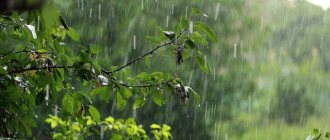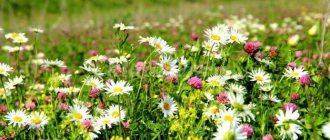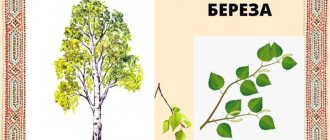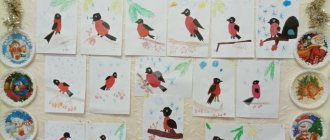Implementation of the program content in educational areas: “Cognitive development”; “Speech development.”
Types of children's activities: Cognitive and research, perception of fiction, communicative.
Goals: expand ideas about the capital of our Motherland - Moscow; introduce them to its sights, teach them to talk about what they learned and saw, and cultivate love for their native land and country.
Target guidelines for preschool education: knows and names the capital of Russia and the region, can tell about the sights of Moscow.
Progress of the lesson
Educator: What is the name of the country in which we live? What language do you and I speak? What is a country?
Children: “These are forests, seas, rivers, mountains, villages, cities...”
Educator: This is the place where we live, where your parents, grandparents, your acquaintances and friends lived. We call Russia our Motherland because we were born and raised. Everything here is dear to us. You and I have a small Motherland - your family, our kindergarten and our city - Bogotol. (The child recites a poem about the Motherland or family.)
Russia is a huge country and many people live in it. In order for there to be peace and order in the country, fair laws are needed that all people of the country would obey. The basic law of our state is the Constitution. The Constitution protects the rights of citizens and young citizens.
Every state has a main city - the capital. The capital of our Motherland is Moscow (I show it on the screen), and the capital of our Krasnoyarsk Territory is the city of Krasnoyarsk (I show it on the screen).
Educator: The main government institutions are located in Moscow - the parliament, where there is a State Duma and the Federation Council (I show the corresponding pictures on the screen), our president and the government of our country work in the Kremlin (ministers are assistants to the president, I show pictures).
The president is the head of state elected by the people. He and the government lead the country, decide important state issues, and approve laws.
Educator: Who knows the name of our president? (Children's answers.)
Educator: Moscow is the largest city in Russia. More than 8 million people live here. Now we will take an excursion to an exhibition of paintings in Moscow. It’s called “I’m Walking Around Moscow.”
Showing a picture (Moscow River and the Kremlin) Pay attention to the battlements and towers, they are made of red brick. One of the towers is Spasskaya, where the largest clock is located. We use them to check our time. There are many educational institutions in Moscow: universities, institutes, academies, where students from all over the world study and use the services of the central library (I show a picture of the central library).
I turn on the song “I am walking around Moscow” and do several exercises with the children (physical minute).
Educator: There are many churches in Moscow: the Annunciation Cathedral, the Archangel Cathedral, the Cathedral of Christ the Savior (I show the corresponding images on the screen).
There are many theaters in Moscow: the Academic Bolshoi Theater, the Maly Theater, and the Sergei Obraztsov Puppet Theater. There are also many squares (I show the corresponding images on the screen). There are also monuments to famous people who lived in this city: Pushkin, Mayakovsky, Tchaikovsky. There are many other attractions here: the Tsar Cannon, the fountain (I show the corresponding images on the screen).
Educator: There are many songs and poems about Moscow. Our children have prepared poems and sayings about Moscow (we listen to the children).
The history of Moscow, its centuries-old traditions, are reflected in the coat of arms of Moscow (I show the coat of arms), the flag, the anthem (I tell you what the flag is and what it means, and the anthem). If you have time left, you can draw the Russian flag.
Reflection: What new did you learn in class today? What did you like? (Children answer.)
Synopsis of the node “Moscow is the capital of our Motherland”
Theme: “Moscow – the capital of our Motherland.”
Target:
continue to introduce children to the main city of Russia - Moscow, to create in children a more holistic image of Moscow - the capital.
Tasks:
educational:
to form in children ideas about the history of Moscow; generalize and expand knowledge about Moscow, about the city’s attractions, improve the ability to recognize them from illustrations; introduce poetry, consolidate knowledge of proverbs and sayings about Moscow; to replenish children's knowledge about individual pages of the history and culture of Moscow, people who left a mark in the memory of the people: about the origin of the name of the city, about Yuri Dolgoruky, about the Moscow Kremlin.
developing:
develop the ability to coordinate words in sentences, cognitive interest; motor activity, fine motor skills.
educational:
to cultivate interest in learning the history of our state, the development of children’s patriotic feelings - a feeling of love and pride for their native land, for their Motherland.
Preliminary work:
familiarization with the map of Russia, conversations about Moscow, looking at illustrations and photographs about Moscow, reading stories, proverbs and sayings about Moscow.
Materials and equipment:
globe, illustrations with views of Moscow: Red Square, Spasskaya Tower, St. Basil's Cathedral, Tsar Bell, Tsar Cannon, White Stone Moscow, the Kremlin, portraits of Yuri Dolgoruky and Empress Anna Ioannovna.
Progress of the lesson
Organizing time:
- Guys, what country do we live in? (in Russia)
Who are we?
(Russians)
Showing the border of Russia on the globe.
Every country has a main city - the capital.
-Who knows what the capital of Russia is called?
-What should the residents of Moscow be called? (Muscovites, Muscovite)
The founder of Moscow was Prince Yuri Dolgoruky ( portrait).
Moscow is dear to every Russian person, because it is the main city of our state - Russia.
Many years ago, on the site of Moscow there were large forests where animals lived; rivers in which there were a lot of fish. People began to settle here, and many small villages were formed. And it was Prince Yu. D. who decided to unite these villages into a city - this is how Moscow appeared. At first, the houses in the city were wooden, and therefore Moscow was called “Wooden” (a conversation about wooden houses and the possibility of fire).
Then, in ancient times, when Moscow was often attacked by enemies, and the wooden walls that surrounded the city periodically burned down during raids, they were replaced with thick walls of white stone (demonstration of the illustration “White Stone Moscow”).
And Moscow began to be called “white stone”.
And later the Kremlin was built from red brick (illustration “The Kremlin”).
This is already modern Moscow. People from all over the world come to Moscow to admire its beauty. So you and I can take a short tour of Moscow today and get acquainted with its sights. Sights are what distinguishes one city from another, what guests remember most.
There are many towers within the walls of the Kremlin, each with its own name. One of them is Spasskaya.
- What is she famous for? (on it is a clock by which the whole country checks time - chimes.)
The Russian government operates in the Kremlin, which governs and directs the life of our country.
Who is the head of our state? (President, full name, draws attention to the portrait in the Patriotic Corner).
And this is the most famous square in Moscow – Red Square (illustration).
Why do you think it is called that?
Precisely because in Rus' it has always been the case that what is beautiful is “red” (“a hut is red not in its corners, but in its pies” and other proverbs and sayings).
What other buildings on Red Square are you already familiar with? (Showing the illustration “St. Blessed Cathedral”)
Moscow has many beautiful churches, theaters, monuments to famous Russians (possibly additional illustrations of the Tretyakov Gallery, Bolshoi Theater, etc.).
But all tourists are sure to rush to see two magnificent monuments - the Tsar Cannon and the Tsar Bell.
This is how it happened in Rus' - everything big and amazing was called the word “tsar”. First, the Tsar Cannon was made. It was cast from cast iron by the wonderful Russian master Andrei Chokhov. The king is a cannon - a cannon to all cannons! It is named so because it has a huge size and weight. It was intended for the defense of the Kremlin, but it was never fired. And the huge cannonballs that lie nearby have nothing to do with the cannon. Who knows why? (because it was supposed to shoot small stones and pieces of iron - “shot”, since this artillery weapon belongs to the so-called shotguns.)
And this, the Tsar, is a bell. It was made by order of the Russian Empress Anna Ioannovna. It was cast by Russian masters Ivan and Mikhail Motorin.
- Why do you think this bell never rang? (once there was a fire in the Kremlin, and the craftsmen, afraid that the fire would melt the bell, began to fill it with cold water; it was because of the temperature difference that the bell cracked and a piece fell off)
The bell cracked due to the temperature difference. For a long time then the Bell lay in the ground, only after 100 years it was removed from the pit and placed on a pedestal.
-Do you guys know proverbs and sayings about Moscow?
— Moscow is the mother of all cities!
“Whoever hasn’t been to Moscow has never seen beauty!”
— Moscow is white-stone, hospitable, golden-domed!
— Moscow is famous for its bells, rolls, and brides.
We all have one homeland - it unites people, and together people are much stronger, they have more opportunities to do great things!
How often in sorrowful separation, in my wandering fate,
Moscow, I was thinking about you. Moscow... so much in this sound
For the Russian heart it has merged! How much resonated with him! (A.S. Pushkin)
Red Square, for many Russians, is Moscow, the capital of our large and vast Motherland. And every resident of the country should visit the capital at least once in their life. Red Square is the most beautiful Moscow square. Russians love their capital very much. Everyone who comes to the capital is in a hurry to walk along its cobblestone streets, visit Red Square and see the sights.
Now I suggest you make an appliqué of “Red Square”, but first we will have a little rest.
Physical education minute:
Let's imagine ourselves as eagles.
With our wings spread wide, we fly under the clouds (we spread our arms and sway from side to side)
And we look around menacingly with very keen eyes (turns around its axis)
We see everything, we hear everything, we notice everything around us (hands on the belt - tilts from side to side)
And we love and defend our great country! (arms spread out and hug themselves)
Before we get to work, let's remember safety precautions with scissors. (children's answers)
Children perform a collective appliqué.
Reflection:
-Guys, what city did we meet? What sights do you remember?
What did you like most?
Cultural development of Moscow
Moscow had the status of capital until 1712, after which Peter I assigned it to St. Petersburg. It was returned only after 1917. But during this time Moscow continued to develop in all directions. Moscow State University (MSU) was opened with the direct participation of the great scientist M.V. Lomonosov. Two gymnasiums appeared - one for the children of the nobility, and the second for the children of commoners and merchants.
The War of 1812 brought great grief to the residents of Moscow, when the city was completely destroyed by fire. However, after the victory of the Russian army over Napoleon's army, it was restored. Thus, Moscow again became a cultural and economic center.
Today, part of the ancient city is located in the very center of the capital. It includes historical buildings, estates and other objects. On the territory of the Kremlin there are religious buildings that are known all over the world: the Arkhangelsk, Annunciation and Assumption Cathedrals.
There are more than 60 theaters, about 100 museums, 75 higher educational institutions, and galleries in the metropolis. More than 4,000 libraries operate for Muscovites and guests of the capital, including the famous “Leninka” (Lenin Library).
The Moscow transport system is unique, which includes railway stations, airports, public transport, and the metro. Some metro stations are architectural monuments. The metro continues to develop and opens new stations for passengers every year.
The Moscow government is doing everything possible to ensure a comfortable stay for Muscovites and guests of the capital. The infrastructure is developing and the city is becoming more modern and practical.





